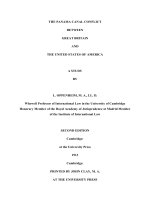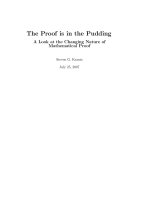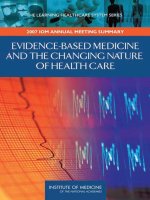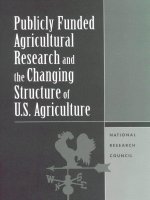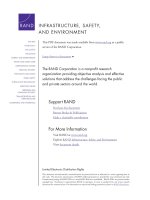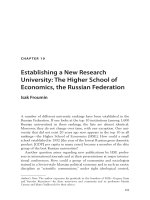Publicly Funded Agricultural Research and the Changing Structure of U.S. Agriculture doc
Bạn đang xem bản rút gọn của tài liệu. Xem và tải ngay bản đầy đủ của tài liệu tại đây (2 MB, 158 trang )
Publicly Funded Agricultural Research and the
Changing Structure of U.S. Agriculture
Committee to Review the Role of Publicly Funded Agricultural
Research on the Structure of U.S. Agriculture
BOARD ON AGRICULTURE AND NATURAL RESOURCES
DIVISION ON EARTH AND LIFE STUDIES
NATIONAL RESEARCH COUNCIL
NATIONAL ACADEMY PRESS
Washington, D.C.
NATIONAL ACADEMY PRESS
2101 Constitution Avenue, N.W.
Washington, D.C. 20418
NOTICE: The project that is the subject of this report was approved by the
Governing Board of the National Research Council, whose members are drawn
from the councils of the National Academy of Sciences, the National Academy of
Engineering, and the Institute of Medicine. The members of the committee
responsible for the report were chosen for their special competences and with
regard for appropriate balance.
This study was supported by Contract/Grant No. 43-3AEL-7-80055 between the
National Academy of Sciences and the U.S. Department of Agriculture Economic
Research Service. Any opinions, findings, conclusions, or recommendations
expressed in this publication are those of the author(s) and do not necessarily
reflect the views of the organizations or agencies that provided support for the
project.
International Standard Book Number 0-309-07616-1
Additional copies of this report are available from National Academy Press, 2101
Constitution Avenue, N.W., Lockbox 285, Washington, D.C. 20055; (800) 6246242 or (202) 334-3313 (in the Washington metropolitan area); Internet,
Suggested citation: National Research Council, 2001. Publicly Funded
Agricultural Research and the Changing Structure of U.S. Agriculture.
Committee to Review the Role of Publicly Funded Agricultural Research on the
Structure of U.S. Agriculture (Washington, DC: National Academy Press).
Cover illustration reprinted, with permission, from Good Directions, Inc.
Copyright 1996 by Good Directions, Inc.
Copyright 2002 by the National Academy of Sciences. All rights reserved.
Printed in the United States of America
The National Academy of Sciences is a private, nonprofit, self-perpetuating society of
distinguished scholars engaged in scientific and engineering research, dedicated to the
furtherance of science and technology and to their use for the general welfare. Upon the
authority of the charter granted to it by the Congress in 1863, the Academy has a mandate
that requires it to advise the federal government on scientific and technical matters. Dr.
Bruce M. Alberts is president of the National Academy of Sciences.
The National Academy of Engineering was established in 1964, under the charter of the
National Academy of Sciences, as a parallel organization of outstanding engineers. It is
autonomous in its administration and in the selection of its members, sharing with the
National Academy of Sciences the responsibility for advising the federal government.
The National Academy of Engineering also sponsors engineering programs aimed at
meeting national needs, encourages education and research, and recognizes the superior
achievements of engineers. Dr. Wm. A. Wulf is president of the National Academy of
Engineering.
The Institute of Medicine was established in 1970 by the National Academy of Sciences
to secure the services of eminent members of appropriate professions in the examination
of policy matters pertaining to the health of the public. The Institute acts under the
responsibility given to the National Academy of Sciences by its congressional charter to
be an adviser to the federal government and, upon its own initiative, to identify issues of
medical care, research, and education. Dr. Kenneth I. Shine is president of the Institute
of Medicine.
The National Research Council was organized by the National Academy of Sciences in
1916 to associate the broad community of science and technology with the Academy’s
purposes of furthering knowledge and advising the federal government. Functioning in
accordance with general policies determined by the Academy, the Council has become
the principal operating agency of both the National Academy of Sciences and the
National Academy of Engineering in providing services to the government, the public,
and the scientific and engineering communities. The Council is administered jointly by
both Academies and the Institute of Medicine. Dr. Bruce M. Alberts and Dr. Wm. A.
Wulf are chairman and vice chairman, respectively, of the National Research Council.
COMMITTEE TO REVIEW THE ROLE OF PUBLICLY FUNDED
AGRICULTURAL RESEARCH ON THE STRUCTURE OF U.S.
AGRICULTURE
ANTHONY S. EARL, Chair, Quarles & Brady LLP, Madison, Wisconsin
MICHAEL BOEHLJE, Purdue University, West Lafayette, Indiana
R. DEAN BOYD, Pig Improvement Company, Franklin, Kentucky
FREDERICK H. BUTTEL, University of Wisconsin, Madison
ARNOLD DENTON* (retired), Campbell Soup Company, Sacramento,
California
ESSEX E. FINNEY† (retired), Agricultural Research Service, United States
Department of Agriculture, Beltsville, Maryland
CORNELIA BUTLER FLORA, Iowa State University, Ames
PETER J. GOLDMARK, DJR Research, Okanogan, Washington
FREDERICK KIRSCHENMANN, Iowa State University, Ames
DAVID ZILBERMAN, University of California, Berkeley
Staff
CLARA COHEN, Study Director (since November 2000)
LEE PAULSON, Study Director (from August 1999 to November 2000)
MARY JANE LETAW, Study Director (from August 1997 to September 1999)
LUCYNA KURTYKA, Program Officer (from August 1999 to July 2000)
ANNE H. KELLY, Editor
KAREN L. IMHOF, Project Assistant
MICHAEL R. KISIELEWSKI, Project Assistant
Consultant
FRED C. WHITE, University of Georgia, Athens
*
†
Resigned, November 4, 1999
Resigned, December 10, 1999
v
BOARD ON AGRICULTURE AND NATURAL RESOURCES
HARLEY W. MOON, Chair, Iowa State University, Ames
CORNELIA B. FLORA, Iowa State University, Ames
ROBERT B. FRIDLEY, University of California, Davis
BARBARA GLENN, Federation of Animal Science Societies, Bethesda,
Maryland
W. R. GOMES, University of California, Oakland
LINDA GOLODNER, National Consumers League, Washington, D.C.
PERRY R. HAGENSTEIN, Institute for Forest Analysis, Planning, and Policy,
Wayland, Massachusetts
GEORGE R. HALLBERG, The Cadmus Group, Inc., Boston, Massachusetts
CALESTOUS JUMA, Harvard University, Cambridge, Massachusetts
GILBERT A. LEVEILLE, McNeil Consumer Healthcare, Denville, New Jersey
WHITNEY MACMILLAN, Cargill, Inc., Minneapolis, Minnesota (retired)
TERRY L. MEDLEY, DuPont BioSolutions Enterprise, Wilmington, Delaware
WILLIAM L. OGREN, U.S. Department of Agriculture (retired)
ALICE PELL, Cornell University, Ithaca, New York
NANCY J. RACHMAN, Novigen Sciences, Inc., Washington, D.C.
G. EDWARD SCHUH, University of Minnesota, Minneapolis
BRIAN STASKAWICZ, University of California, Berkeley
JOHN W. SUTTIE, University of Wisconsin, Madison
JAMES TUMLINSON, Agriculture Research Service, U.S. Department of
Agriculture, Gainesville, Florida
JAMES J. ZUICHES, Washington State University, Pullman
Staff
WARREN MUIR, Executive Director
CHARLOTTE KIRK BAER, Director
JULIE ANDREWS, Senior Project Assistant
vi
Preface
The food and agricultural economy is highly concentrated today. Economic
concentration characterizes food distribution and processing, agricultural inputs,
and, increasingly, primary production and commercial farming. Six million
farms produced the nation’s food during World War II. Today, 90 percent of all
farm output comes from fewer than a million farms. This trend is unlikely to be
reversed, but it nonetheless troubles U.S. society, which values the concept of
the family farm, as farm legislation consistently mentions the family farm as part
of its justification and goals.
Vertical integration and contracting increasingly characterize the U.S. food
and agricultural system. Vertically integrated farming, processing, and marketing
activities often are components of a single corporate entity. Subcontractors might
manage a crop or livestock operation while livestock and other assets are owned
and much of the decision making is controlled by the farm, which acts as
integrator.
In contrast to vertical integration and contracting, but also in response to
highly differentiated consumer demands, is the rise in some regions of a segment
of farmers engaged in production for niche markets. Niche marketers produce
specialty crops or use alternative management practices and typically are
independent, small-scale producers. They often market directly to small grocers,
specialized outlets, or urban farmers’ markets.
The changing food and agricultural system poses major challenges for the
public sector’s food and agricultural research and educational system. One major
vii
viii
PREFACE
challenge is the complexity associated with meeting the research, extension, and
education needs of agricultural producers. A concern expressed by Congress and
other observers is the putative role of publicly funded agricultural research in
developing technologies that have been or will be biased toward changes in farm
size and other characteristics of the structure of agriculture.
In response to these concerns, the U.S. Department of Agriculture (USDA)
asked the National Research Council (NRC) to review the relationship between
publicly funded research and the evolving structure of agriculture.
The NRC convened a study panel of experts chosen for their knowledge of
agricultural policy issues, farm and agribusiness management and finance, rural
sociology, agricultural economics, and the land grant system. The committee had
the following charges:
·
·
·
·
Assess the role of public-sector research on changes in farm size and
numbers, with particular emphasis on very-large-scale operations.
Review relevant literature, including pertinent rural development literature,
on the role of research and the development of new technology in promoting
structural change in farming, evaluating theoretical and empirical evidence.
Consider whether public-sector research has influenced the size of farm
operations and, if so, by what means.
Provide recommendations for future research and extension policies, giving
consideration to improving access to the results of public-sector research
that leads to new farm production practices and technology.
As part of its information-gathering activities, the committee held public
workshops to elicit the perspective of producers, particularly those who are often
described as underserved by the current public research agenda, and other
experts on the structure of agriculture. The committee reviewed a wide array of
background material, including long-term trends in public and private
agricultural research, USDA budgets, literature on economic and sociologic
research, literature on adoption and diffusion, and on the relationship among
public research, farm size, and structural characteristics. The committee also
considered reports on minority and women farmers, the report of the USDA
National Commission on Small Farms, and reports by the Congressional Office
of Technology Assessment on the structure of agriculture.
This report analyzes the implications of public-sector research, technology
adoption, technology transfer, and distribution of public-sector research
investments for the structure of agriculture. The report also frames public-sector
research and development in the context of other drivers of structural change in
agriculture, including market forces, public policy, and the changing role of
knowledge and information. The study committee offers recommendations for
changes in the public sector’s research approach and priority-setting process and
for strengthening research programs devoted to analysis of structural change, its
PREFACE
ix
causes, and its implications. The study committee hopes that Congress and the
Executive Branch will use these recommendations ultimately to benefit a broad
diversity of agricultural constituents.
Anthony S. Earl, Chair
Committee to Review the Role of Publicly Funded Agricultural Research on the
Structure of U.S. Agriculture
Acknowledgments
Many individuals generously contributed their time, advice, data, and other
input during the study process. The committee gives special thanks to those who
provided input at its public workshops:
GLENN ANDERSON, Organic Farms
ROBERT EVENSON, Yale University
GAIL FEENSTRA, University of California, Davis
ROGER GERRITS, (formerly) Agricultural Research
Service, U.S. Department of Agriculture
ROBERT GOODMAN, University of Wisconsin, Madison
CHARLES HASSEBROOK, Center for Rural Affairs
JAY HARMON, Iowa State University
DOUGLAS JACKSON-SMITH, Utah State University
DESMOND JOLLEY, University of California, Davis
MARLYN JORGENSEN, Jorg-Anna Farms, Iowa
NOEL KEEN, University of California, Riverside
EDWARD KNIPLING, Agricultural Research Service, U.S.
Department of Agriculture
MARGARET KROME, Michael Fields Agricultural Institute
MICHELLE MASCARENHAS, Occidental College
DANIEL MOUNTJOY, Natural Resources Conservation Service,
U.S. Department of Agriculture
xi
xii
ACKNOWLEDGMENTS
TERRY NIPP, AESOP Enterprises, Ltd.
KEN OLSON, American Farm Bureau Federation
CALVIN QUALSET, University of California, Davis
SARAH J. ROCKEY, Cooperative State Research, Education, and
Extension Service, U.S. Department of Agriculture
JAMES VAN DER POL, Minnesota Institute for Sustainable
Agriculture
MICHAEL WEHLER, Upland Prairie Farms, Wisconsin
JAMES ZUICHES, Washington State University
The following are also acknowledged for assisting the National Research
Council staff during preparation of the report by providing information and
statistics: George Cooper, Cooperative State Research, Education, and Extension
Service, U.S. Department of Agriculture; Robert Hoppe, Economic Research
Service, U.S. Department of Agriculture; Charles Krueger, Pennylvania State
University; Richard Pirog, Leopold Center for Sustainable Agriculture; Deborah
Sheely, Cooperative State Research, Education, and Extension Service, U.S.
Department of Agriculture; Frank Shelton, National Agricultural Statistics
Service, U.S. Department of Agriculture; Barbara Tidwell, National Agricultural
Statistics Service, U.S. Department of Agriculture; Luther Tweeten, Oklahoma
State University; and Dennis Unglesbee, Cooperative State Research, Education,
and Extension Service, U.S. Department of Agriculture.
The committee is extremely grateful to the staff members of the National
Research Council Board on Agriculture and Natural Resources (BANR) for their
efforts throughout the study process and the preparation of this report. The
committee also would like to acknowledge Fred C. White for technical
assistance, Anne H. (Kate) Kelly for her editorial assistance, and Michael
Kisielewski for his efforts in preparing the report. The committee wishes to
extend special thanks to Clara Cohen, Study Director since November, 2000, for
her dedicated efforts in shepherding the completion of the report.
This report has been reviewed in draft form by individuals chosen for their
diverse perspectives and technical expertise, in accordance with procedures
approved by the NRC’s Report Review Committee. The purpose of this
independent review is to provide candid and critical comments that will assist the
institution in making its published report as sound as possible and to ensure that
the report meets institutional standards for objectivity, evidence, and
responsiveness to the study charge. The review comments and draft manuscript
remain confidential to protect the integrity of the deliberative process. We wish
to thank the following individuals for their review of this report:
MAGGIE ADAMEK, Vision for Change, University of Minnesota
JANET BOKEMEIER, Michigan State University
RUSSELL CROSS, Future Beef
ACKNOWLEDGMENTS
xiii
WALLACE HARDIE, Fairmount, North Dakota
JAY HARMON, Iowa State University
CHARLES HASSEBROOK, Center for Rural Affairs
WALLACE HUFFMAN, Iowa State University
D. GALE JOHNSON, University of Chicago
NEAL VAN ALFEN, University of California, Davis
Although the reviewers listed above have provided many constructive comments
and suggestions, they were not asked to endorse the conclusions or
recommendations nor did they see the final draft of the report before its release.
The review of this report was overseen by James Cook, Washington State
University, and W. R. Gomes, University of California, Oakland. Appointed by
the National Research Council, they were responsible for making certain that an
independent examination of this report was carried out in accordance with
institutional procedures and that all review comments were carefully considered.
Responsibility for the final content of this report rests entirely with the authoring
committee and the institution.
Contents
EXECUTIVE SUMMARY
1
The Study Process, 2
Project Scope, 3
Publicly Funded Agricultural Research, 3
The Structure of Agriculture, 4
Conclusions and Findings, 5
Recommendations, 8
Research Approach, 8
Broaden Public Goals Beyond Production and Efficiency, 8
Biophysical and Social Sciences Research, 9
Public Research, Stakeholder Participation, and
Accountability, 10
Assess the Structural Impacts of Publicly Funded Agricultural
Research, 11
Extension Policy, 11
Respond to Broad Variety of Producers, Particularly
Underserved Populations, 11
Extension and Engagement, 13
Future Research, 13
Monitor and Analyze Structural Change, 13
Serve Diverse Producers, 14
xv
xvi
CONTENTS
1 INTRODUCTION
The Study Process, 22
Structural Changes in U.S. Agriculture, 24
Publicly Funded Agricultural Research, 26
Sources of Public Resource Funds, 26
Institutions Performing Publicly Funded Agricultural Research, 27
Privately Funded Agricultural Research, 28
Report Organization, 29
16
2
STRUCTURAL IMPACTS OF RESEARCH
Research and the Structure of Agriculture, 30
Innovation and the Structure of Agriculture, 32
Mechanical Innovations, 33
Chemical Innovations, 34
Innovations in Biology, 35
Managerial Innovations, 37
Innovations Applied, 39
Green Revolution, 39
Tomato Harvester, 40
Animal Agriculture, 41
Structural Implications of the Research Priority-Setting Process, 43
Criteria for Setting Priorities in Agricultural Research, 43
Stakeholder Participation, 48
Structural Impact Assessments, 49
Summary, 50
30
3
STRUCTURAL IMPLICATIONS OF TECHNOLOGY TRANSFER
AND ADOPTION
Factors that Affect Technology Adoption, 52
Farm Size, 53
Regional Differences in Land Quality, 55
Human Capital, 56
Producer Age, 56
Tenure Arrangements, 57
Responding to a Broad Variety of Producers, Including Underserved
Populations, 57
Technology Transfer, 59
Market-Oriented Technology Transfer, 60
Extension: Public-Sector Technology Transfer, 61
Structural Impacts of Extension, 61
Populations Targeted by Extension, 61
52
CONTENTS
xvii
Changing the Focus of Technology Transfer Programs, 63
Partnerships with the Private Sector, 63
Partnerships among Public-Sector Institutions, 64
Changes in Extension Structure, 65
Changes in Extension Function, 65
Changes in Extension Process, 67
Summary, 68
4
5
STRUCTURAL IMPACTS OF PUBLIC INVESTMENT IN
AGRICULTURAL RESEARCH
Public-Sector Responses to Structural Issues, 69
Agricultural Research Investments, 72
Current Research Information System, 72
Public Research Spending, 1986 and 1997, 73
Public Research Spending, 1999, 78
Public Research and Environmentally Sustainable Alternative
Agriculture, 79
Structural Implications of Research Funding Mechanisms, 82
Fund for Rural America, 82
Initiative for Future Agriculture and Food Systems, 83
National Research Initiative Competitive Grants Program, 83
Summary, 85
69
DRIVERS OF STRUCTURAL CHANGE, CHANGES IN KNOWLEDGE
AND INFORMATION, IMPLICATIONS FOR POLICY
86
Drivers of Structural Change, 86
Relative Price of Labor and Capital, 87
Knowledge and Information: A Changing Role, 89
Government Policy and Structure, 90
Changes in Farming, 92
Global Competition, 92
Industrialized Agriculture, 92
Differentiated Products, 93
Precision (Information-Intensive) Production, 93
Ecologic Agriculture, 94
Food Supply Chains, 94
Increasing Risk, 95
Increasing Diversity, 96
Information, Innovation, and the Structure of Agriculture, 97
Structure and Coordination, 97
Intellectual Property Rights and Distributional Consequences, 99
Global R&D and Information, 101
xviii
CONTENTS
Access to Technology and Disenfranchisement, 101
Research Opportunities, 103
Summary, 103
REFERENCES
105
APPENDIXES
A Committee to Review the Role of Publicly Funded Agricultural
Research on the Structure of U.S. Agriculture, Public Workshop,
November 19, 1999
119
B Committee to Review the Role of Publicly Funded Agricultural
Research on the Structure of U.S. Agriculture, Public Workshop,
January 18, 2000
122
C U.S. Public (USDA and State Agricultural Experiment Stations)
and Private Agricultural Research Funds by Performing Organization,
1888–1990 (Millions of Dollars)
125
D Economic Research Service Farm Typology
129
ABOUT THE AUTHORS
131
BOARD ON AGRICULTURE AND NATURAL RESOURCES
PUBLICATIONS
135
Tables, Figures, and Boxes
Tables
3-1
4-1
4-2
4-3
4-4
Contact with Extension by Herd Size, 62
Historic Allocation of Public Research Funds by Commodity, 74
Historic Allocation of Public Research Funds by Goal, 75
Allocation of Public Agricultural Research Funds, 1999, 77
Selected Alternative Agricultural Technologies: Current USDA-Funded
Projects and Total Patents Granted, 1975–1998, by Type of Organization,
80
Figures
1-1 Number of Farms and Acres Per Farm, 1850–1997, 17
1-2 Smallest Percentage of U.S. Farms Accounting for Half of the Nation’s
Agricultural Sales, Selected Years from 1900–1997, 18
1-3 Share of Hog Production by Type of Vertical Coordination, 1970–1999, 20
3-1 Technology Adoption by Dairy Herd Size, 1999, 54
Boxes
1-1 Public Sources of Funding for Agricultural Research, 26
xix
xx
TABLES, FIGURES, BOXES
3-1 Responding to Asian Growers in California, 59
3-2 State Extension Partners are Linking to Other Federal Agencies on a Broad
Array of Problems, 66
3-3 Stakeholder Participation and SARE, 67
3-4 Fax-Based, Satellite Information Request System: Reaching Small and
Part-Time Farmers, 68
4-1 Public-Sector Responses to Structural Issues, 70
4-2 Research Funding and Structural Change, 83
Executive Summary
The U.S. food and agricultural sector is undergoing rapid change in
production, distribution, and consumption of food and fiber, and in technology.
There have been dramatic increases in production and marketing coordination,
market contracting, concentration of agricultural output by fewer and fewer
operations, and consolidation of agricultural operations. These increases are
manifested in significant long- and short-term changes in farm size, number,
distribution, and location. Production that once relied on small, independent,
family-based farms increasingly occurs in large, consolidated, global operations.
Small- and mid-sized operators often struggle to remain competitive and to adopt
recent developments in technology and information.
The changes occurring in the modern food and agricultural system pose
major challenges for public-sector agricultural research and education. One
challenge is the complexity of serving and meeting the needs of agricultural
producers—both the large commercial agricultural production sector and the
multitude of smaller producers, including low-income and limited-resource
producers, and producers of niche commodities. There is concern that publicly
funded agricultural research has influenced the development of technologies that
have been or will be biased toward changes in farm size and industrialization of
the farm sector. There is debate about whether publicly funded agricultural
research is equally accessible to all users and whether it is targeted to the full
range of user and citizens’ groups.
1
2
PUBLICLY FUNDED AGRICULTURAL RESEARCH
This report analyzes publicly funded agricultural research and the structure
of agriculture, and it offers recommendations for research and extension policies.
It evaluates the applicability of publicly funded agricultural research across the
agricultural distribution system: from small, poorly capitalized farms to large,
well-capitalized industrial organizations. Although the committee acknowledges
that the public sector has been encouraged, and in some cases mandated, to serve
constituents, as illustrated by the increasing public policy support for small
farmers and other underserved groups in the last four farm bills, the focus of this
report is on analysis without judgment about the social desirability of particular
distributions.
THE STUDY PROCESS
The U.S. Department of Agriculture (USDA) requested that the Board on
Agriculture and Natural Resources of the National Research Council (NRC)
convene a panel of experts to examine whether publicly funded agricultural
research has influenced the structure of U.S. agriculture and, if so, how. The
Committee to Review the Role of Publicly Funded Agricultural Research on the
Structure of U.S. Agriculture was asked to assess the role of public-sector
agricultural research on changes in the size and numbers of farms, with particular
emphasis on the evolution of very-large-scale operations. The committee’s
charge was as follows:
·
·
·
Review relevant literature, including pertinent rural development
literature, on the role of research and the development of new
technology in promoting structural change in farming, evaluating
theoretical and empirical evidence.
Consider whether public-sector research has influenced the size of farm
operations and, if so, by what means.
Provide recommendations for future research and extension policies,
giving consideration to improving access to the results of public-sector
research that leads to new farm production practices and technology.
The committee analyzed publicly funded agricultural research documented
in the Current Research Information Systems (CRIS) database, which is the
USDA’s documentation and reporting system for research projects in agriculture,
food and nutrition, and forestry. It also considered information drawn from case
studies and from the scientific literature. The committee gathered input and
information from stakeholders during two public workshops held in conjunction
with this study (Appendixes A and B).
EXECUTIVE SUMMARY
3
PROJECT SCOPE
Publicly Funded Agricultural Research
Publicly funded agricultural research comprises a complex variety of
programs, users, and funding sources. The committee considered publicly funded
agricultural research to be any agricultural research performed with financial
and material support from the public sector. Sources of public-sector support
include international organizations and federal, state, and local governments.
The proportion of public funds in any research activity varies by institution and
project. Publicly funded agricultural research is performed in public- and
private-sector institutions.
The committee elected not to survey and analyze comprehensively all
sources of publicly funded agricultural research, given the challenges in defining
and disaggregating investments in agricultural research over time across different
agencies and in determining their relationship to structural variables. The
committee instead chose to limit the scope of its analysis to a subset of publicly
funded agricultural research that could be used as a proxy for the wider scope of
research described above. The committee chose to emphasize the principal
components of USDA-supported agricultural research and extension, including
extramural scientific research support to state-level partners and other research
programs administered by the Cooperative State Research, Education, and
Extension Service (CSREES); intramural biophysical science research conducted
by the Agricultural Research Service (ARS); intramural social science research
conducted by the Economic Research Service (ERS); the collection and analysis
of agricultural data by the National Agricultural Statistics Service (NASS); and
research conducted by the USDA Forest Service. The committee also considered
state- and federally supported institutions, including land grant institutions,
colleges of agriculture, agricultural experiment stations, the Cooperative
Extension service, schools of forestry, historically African American land grant
institutions, colleges of veterinary medicine, colleges of human sciences, Native
American land grant institutions, and Hispanic-serving institutions.
The committee relied heavily on data reported to the CRIS database by
USDA intramural research agencies, state agricultural experiment stations, 1890
and 1862 land grant universities, state schools of forestry, schools of veterinary
medicine, and USDA grant recipients. Although the committee acknowledges
limitations of the CRIS in comprehensively reporting research conducted by
other non-USDA agencies, CRIS is the most reliable and consistent database
available.
The committee acknowledges that private sources of funding for
agricultural research have grown significantly relative to public sources
4
PUBLICLY FUNDED AGRICULTURAL RESEARCH
(Huffman and Evenson, 1993; See table in Appendix C). The committee
recognizes that mutual influence exists between private and public research, both
through the input of public research results into private-sector research and
through the influence of the private sector on the public-sector research agenda
through funding provision. Public-private partnerships are increasingly used as a
mechanism for technology transfer (discussed in greater detail in Chapter 3). The
committee acknowledges that linkages between the public and the private sectors
are important and are likely to have significant implications for the structure of
agriculture. However, an analysis of the relationship between privately funded
agricultural research and the structure of agriculture is beyond the scope of this
report. It is an important issue that should be the focal point of further analysis.
The Structure of Agriculture
The “structure of agriculture” is a broad phenomenon involving both the
characteristics of farms (the system of agricultural production) and the
relationships of farms to other sectors and institutions. “Structural change” refers
to the change in those characteristics over time. While there is no universally
accepted definition, there is considerable agreement that farm structure involves
matters such as:
·
·
·
·
·
·
·
·
·
·
·
The size (measured in acreage or gross farm sales) and size distribution of
agricultural operations, including the concentration of agricultural
production—the increasing share of agricultural output by fewer firms.
The number of agricultural operations.
The spatial character of production systems.
The technology and production characteristics of agricultural operations,
including the level of specialization and diversification.
Resource ownership arrangements, including tenancy and leasing.
The relationship among ownership, management, and labor.
Dependence on primary resources, or the relative degree to which an
operation depends on capital, labor, or knowledge.
Inter- and intrasectoral linkages, including contractual relationships for
marketing and production.
The extent and pattern of vertical and horizontal integration.
Production, marketing, and financial management strategies.
Business organization (including sole proprietorships, partnerships,
corporations and cooperatives) and arrangements (including joint ventures,
leasing, independent production, and contracting).
